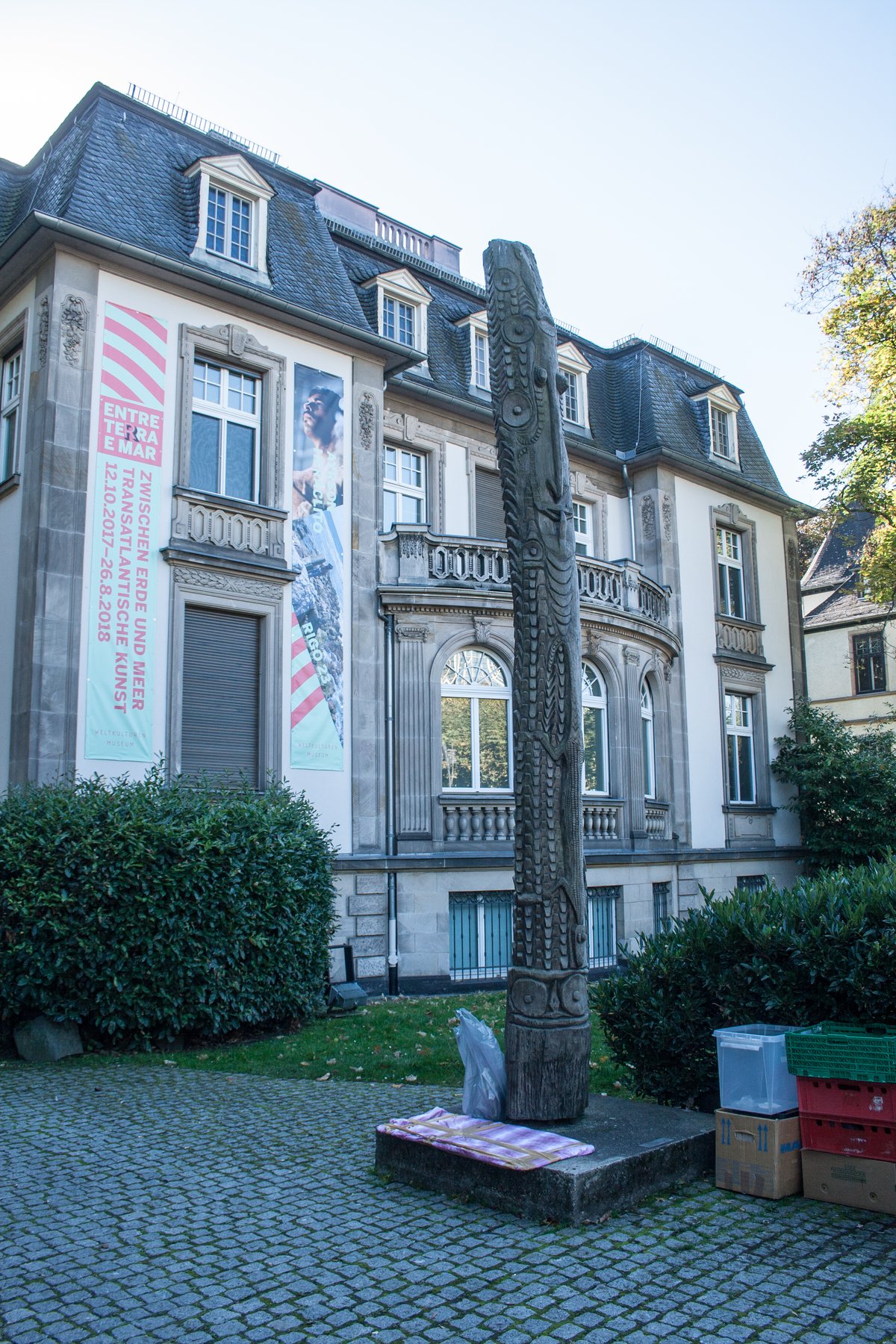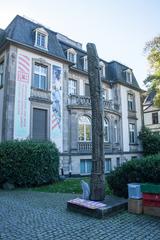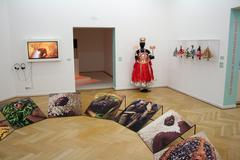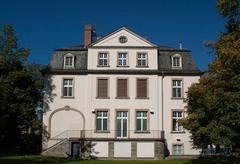
Weltkulturen Museum Frankfurt: Visiting Hours, Tickets, and Visitor Guide
Date: 03/07/2025
Introduction: The Significance of the Weltkulturen Museum in Frankfurt
Located on Frankfurt’s picturesque Museumsufer, the Weltkulturen Museum is a leading institution dedicated to exploring the diversity of world cultures. Established in 1904, it has transformed from a municipal ethnological collection into a dynamic hub that fosters intercultural dialogue, critical examination of colonial histories, and contemporary artistic engagement. The museum’s collection comprises approximately 65,000–67,000 artifacts from Oceania, Africa, Southeast Asia, the Americas, and Europe, complemented by an archive of around 120,000 photographs and films, providing vivid insights into global traditions and social transformation (Weltkulturen Museum Frankfurt: Visiting Hours, Tickets, History & Architectural Highlights; Visiting the Weltkulturen Museum in Frankfurt: Hours, Tickets, Exhibitions & Visitor Guide; Exhibitions, Educational Programs, and Visitor Experience at the Weltkulturen Museum Frankfurt).
Central to its mission is the Weltkulturen Labor—an experimental research space promoting interdisciplinary collaboration among artists, scholars, and communities. This space exemplifies the museum’s commitment to decolonizing museology by inviting alternative narratives, participatory exhibitions, and critical engagement with the colonial histories embedded in ethnographic objects (Weltkulturen Museum Frankfurt: Visiting Hours, Tickets & Intercultural Dialogue).
Situated at Schaumainkai 29–37 in beautifully restored 19th-century villas, the museum blends historical architecture with modern standards. It’s open Tuesday to Sunday, offers affordable tickets (with free admission for children under 18 and on special occasions), and features barrier-free access and programs tailored for diverse needs. Its location along Frankfurt’s Museumsufer makes it an ideal destination for a full day of cultural exploration (Weltkulturen Museum Frankfurt: Visiting Hours, Tickets, History & Architectural Highlights; Exhibitions, Educational Programs, and Visitor Experience at the Weltkulturen Museum Frankfurt).
Whether you are a history enthusiast, art lover, or a family seeking an engaging educational experience, the Weltkulturen Museum invites you to reflect on shared heritage and the evolving role of museums in society. For up-to-date visitor information, tickets, and exhibitions, visit the official website.
Contents
- Visiting the Museum: Hours, Tickets, and Accessibility
- History and Development
- Architectural Highlights
- Collections and Exhibitions
- Research and Collaborations
- The Weltkulturen Labor
- Planning Your Visit: Essential Information
- Educational Programs and Visitor Experience
- Frequently Asked Questions (FAQ)
- Summary and Visitor Tips
- Sources
Visiting the Weltkulturen Museum: Hours, Tickets, and Accessibility
Hours and Days of Operation
- Tuesday–Sunday: 10:00 or 11:00 AM to 5:00 or 6:00 PM (check the official website for precise, current hours)
- Closed: Mondays and some public holidays
Ticket Prices
- Adults: €6–8
- Reduced (students, seniors): €3–5
- Children under 18: Free
- Special offers: Free admission on the last Saturday of each month and during select events
Tickets are available both on-site and online.
Accessibility
- The museum is largely wheelchair accessible, with ramps, elevators, and adapted restrooms.
- Guided tours and workshops can be tailored for visitors with disabilities; contact the museum in advance for specific needs.
Getting There
- Address: Schaumainkai 29–37, 60594 Frankfurt am Main, Germany
- Public transport: Tram and bus stops are nearby; parking is limited, so public transport is recommended.
Historical Development of the Weltkulturen Museum
- Founded in 1904 as the “Städtisches Völkermuseum,” the museum’s origins are civic, not royal.
- Collections began in 1817 with the Senckenberg Natural History Society and later transferred to Frankfurt’s city ownership (Weltkulturen Museum – History).
- Growth in the early 20th century led to relocation and expansion, notably under director Leo Frobenius in the 1920s and 1930s.
- World War II caused significant losses, but key objects were preserved through evacuation.
- In 1973, the museum reopened in a renovated villa on the Museumsufer, expanding over the next decades into three adjacent villas.
- Officially renamed “Museum der Weltkulturen” in 2001, reflecting its global mission.
- Recent years have seen both renovations (notably in 2011) and plans for further expansion into Frankfurt’s banking district (Museumsufer – Weltkulturen Museum).
Architectural Highlights
- Schaumainkai Villas: Three late 19th-century villas house the museum.
- No. 29: Main exhibition space, recently renovated for accessibility and flexible displays
- No. 35: Administration and specialized library with 50,000+ volumes
- No. 37: Weltkulturen Labor for experimentation, workshops, and artist residencies
- Future Expansion: Plans to open a new branch in a historic high-rise at Neue Mainzer Straße by 2028, broadening exhibition capacity (Museumsufer – Weltkulturen Museum).
Collections and Exhibitions
Permanent Collection
- 67,000 objects from Africa, Oceania, Southeast Asia, the Americas, and Europe (Kultur Frankfurt; Museen in Hessen)
- Photographic Archive: 120,000+ images and films
- Library: 50,000+ books and journals (Frankfurt.de)
Special and Temporary Exhibitions
- “Country bin pull’em. Looking back together” (Nov 2024 – Aug 2025): Focus on Australian Indigenous rock art, provenance research, and cultural restitution (museumsufer.de; weltkulturenmuseum.de)
- Past exhibitions have addressed global healing practices, mortality, and contemporary identity issues.
- Exhibition Philosophy: Emphasis on collaborative curation, critical provenance research, and participatory interpretation.
Research and Collaborations
- The museum conducts interdisciplinary projects connecting ethnology, art, and cultural studies.
- Notable collaborations include co-curated exhibitions with the Wanjina Wunggurr Community and the Frobenius Institute (Weltkulturen Museum).
- Projects emphasize decolonizing practices, provenance research, and partnerships with source communities.
The Weltkulturen Labor: Innovation and Engagement
- An experimental hub for research, artistic practice, and education (Kultur Frankfurt).
- Activities:
- Object reinterpretation with artists and scholars
- Exhibition development
- Residencies and workshops for international guests
- Community engagement and participatory programming (Museen in Hessen)
Planning Your Visit: Essential Information
Location and Getting There
- Address: Schaumainkai 29–37, Museumsufer, central Frankfurt (Museen in Hessen)
- Public transport: Tram and bus stops nearby; limited parking
Tickets and Admission
- Adults: €6–8
- Reduced: €3–5
- Children under 18: Free
- Free admission on the last Saturday of each month
Accessibility
- Most areas are wheelchair accessible; contact in advance for specific needs
Facilities
- Lockers and cloakroom
- Small café and museum shop
- Restrooms available
Travel Tips
- Combine your visit with nearby Museumsufer attractions
- English-language guided tours available for major exhibitions
- Photography is allowed in most exhibitions unless otherwise indicated
Educational Programs and Visitor Experience
- Workshops and Tours: For families, schools, and adults
- Hands-on learning: Object-based workshops and guided tactile experiences
- Library: Open for public research and reading (weltkulturenmuseum.de)
Frequently Asked Questions (FAQ)
Q: What are the museum’s visiting hours?
A: Tuesday–Sunday, generally 10:00 or 11:00 AM to 5:00 or 6:00 PM; closed Mondays.
Q: How much are tickets?
A: Adults €6–8; reduced €3–5; free for children under 18.
Q: Is the museum accessible?
A: Most areas are wheelchair accessible; contact the museum for assistance.
Q: Are guided tours available in English?
A: Yes, regular English-language tours are offered for major exhibitions.
Q: Can I take photos?
A: Yes, unless otherwise indicated; no flash or tripods.
Q: What other museums are nearby?
A: Städel Museum, German Film Museum, Jewish Museum, and more on the Museumsufer.
Summary and Visitor Tips
The Weltkulturen Museum Frankfurt is a vibrant institution where history, cultural diversity, and critical scholarship converge. Its vast collections and innovative programs—especially through the Weltkulturen Labor—set a benchmark for modern, decolonizing museum practice (Weltkulturen Museum Frankfurt: Visiting Hours, Tickets & Intercultural Dialogue; Visiting the Weltkulturen Museum in Frankfurt: Hours, Tickets, Exhibitions & Visitor Guide). Its location in architecturally significant villas on the Museumsufer, accessible facilities, and affordable admission make it a must-visit for anyone interested in global cultures.
Plan your visit ahead, explore special exhibitions, and enhance your experience with the Audiala app. Follow the museum’s social media for updates, and explore Frankfurt’s rich cultural neighborhood for a full day of discovery (Weltkulturen Museum Frankfurt: Visiting Hours, Tickets, History & Architectural Highlights; Exhibitions, Educational Programs, and Visitor Experience at the Weltkulturen Museum Frankfurt).
Sources
- Weltkulturen Museum Frankfurt: Visiting Hours, Tickets, History & Architectural Highlights
- Visiting the Weltkulturen Museum in Frankfurt: Hours, Tickets, Exhibitions & Visitor Guide
- Weltkulturen Museum Frankfurt: Visiting Hours, Tickets & Intercultural Dialogue
- Exhibitions, Educational Programs, and Visitor Experience at the Weltkulturen Museum Frankfurt: Visiting Hours, Tickets, and More









































